Football Coaching Plan: A Holistic Approach for Under 18 Team Success
VerifiedAdded on 2020/04/21
|24
|4571
|560
Project
AI Summary
This project presents a detailed football coaching plan designed for an under 18 team. It emphasizes a holistic approach encompassing physical, technical, tactical, and psychological development. The plan outlines a 6-week coaching strategy with specific goals, a meso-cycle schedule, and detailed session plans, including warm-up activities, agility drills, and cool-down exercises. The coaching philosophy centers on an athlete-centered approach, promoting individual capabilities, and fostering a positive learning environment. It incorporates elements of Teaching Games for Understanding (TGfU) and emphasizes player empowerment and emotional intelligence. The plan aims to enhance agility, passing, dribbling, and shooting skills while also developing decision-making proficiency. The plan includes a focus on physical fitness, technical skills, tactical understanding, and psychological readiness, with a focus on agility drills and game strategies. This coaching plan aims to improve the team's performance and help players achieve their individual goals.
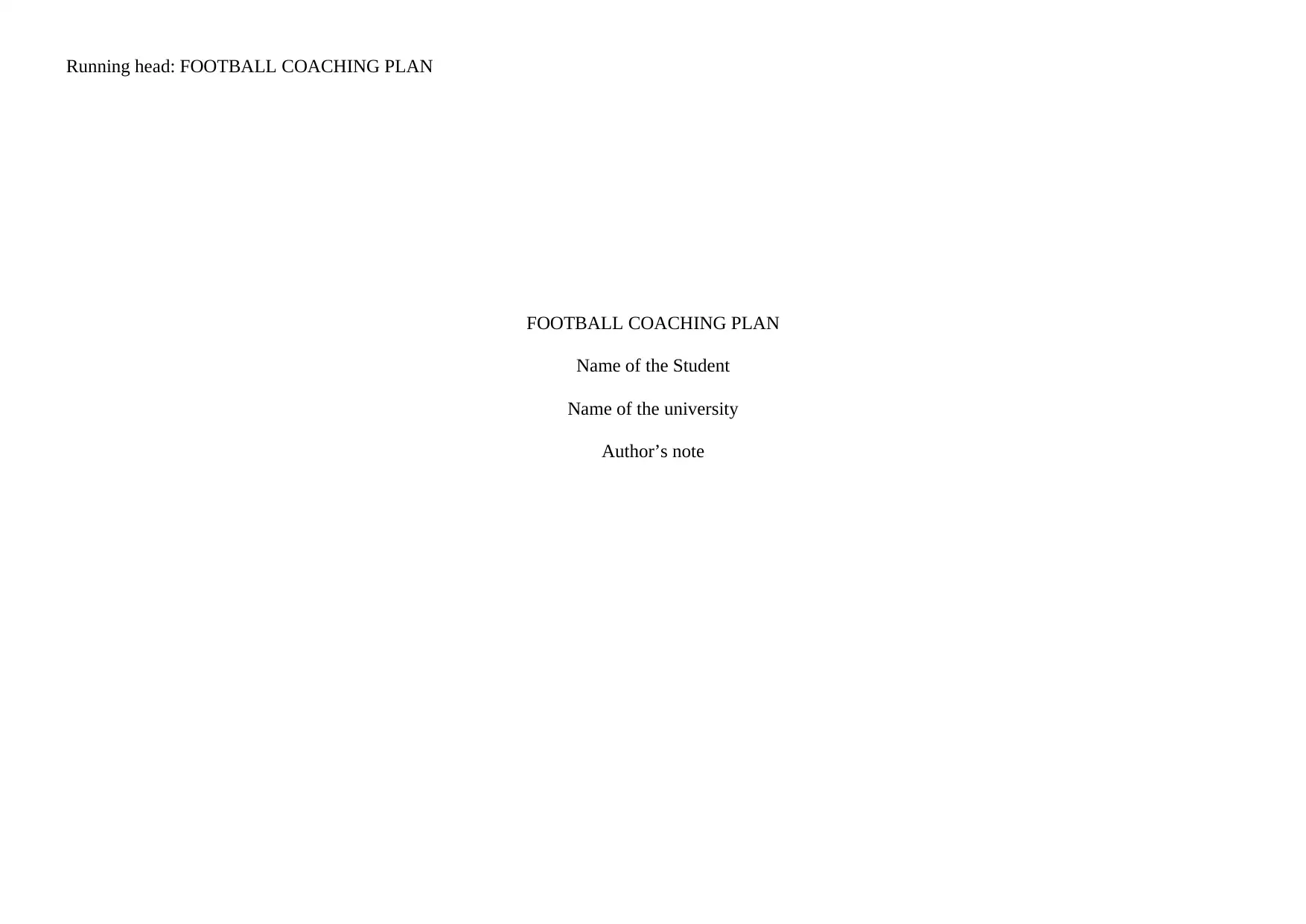
Running head: FOOTBALL COACHING PLAN
FOOTBALL COACHING PLAN
Name of the Student
Name of the university
Author’s note
FOOTBALL COACHING PLAN
Name of the Student
Name of the university
Author’s note
Paraphrase This Document
Need a fresh take? Get an instant paraphrase of this document with our AI Paraphraser
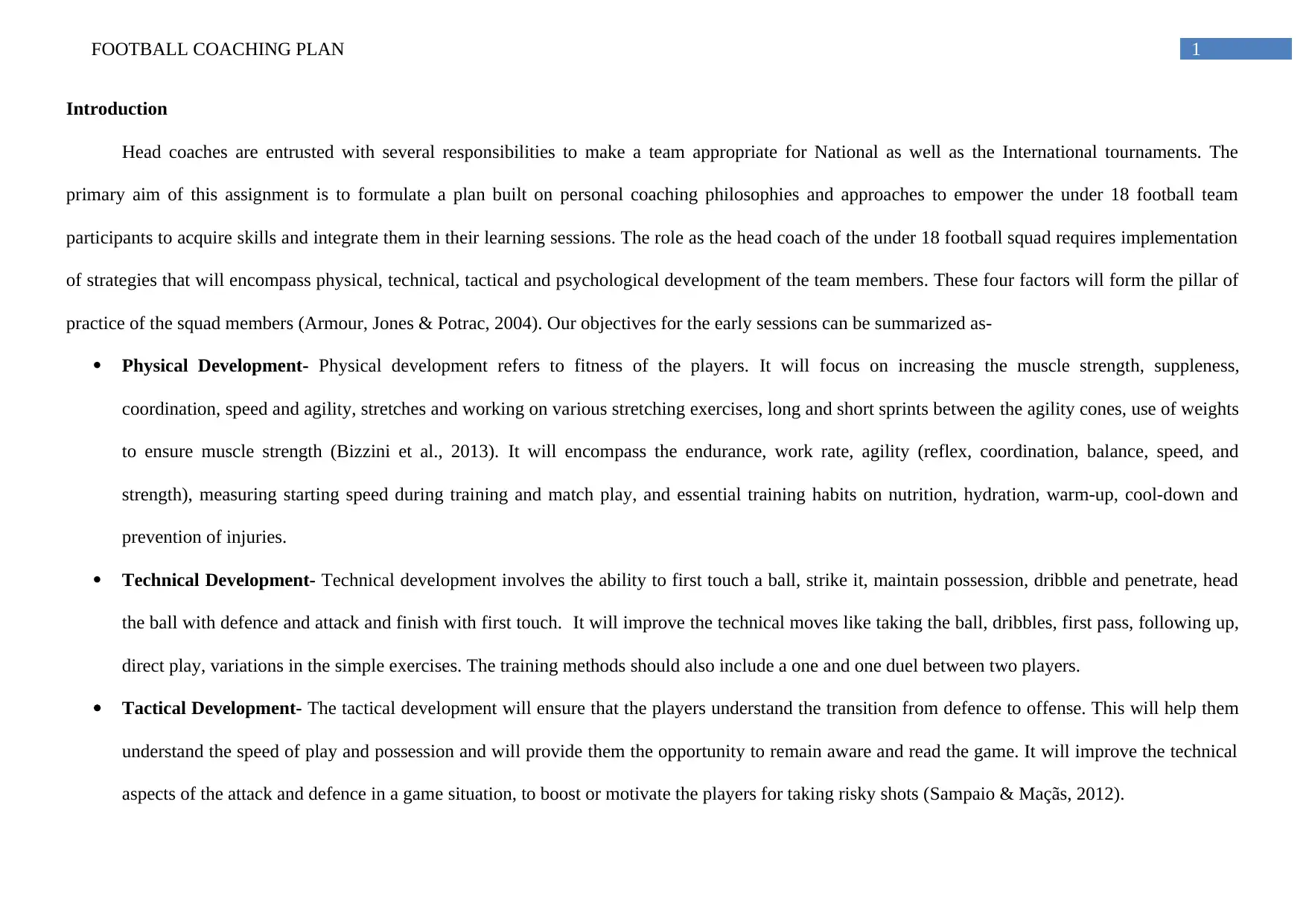
1FOOTBALL COACHING PLAN
Introduction
Head coaches are entrusted with several responsibilities to make a team appropriate for National as well as the International tournaments. The
primary aim of this assignment is to formulate a plan built on personal coaching philosophies and approaches to empower the under 18 football team
participants to acquire skills and integrate them in their learning sessions. The role as the head coach of the under 18 football squad requires implementation
of strategies that will encompass physical, technical, tactical and psychological development of the team members. These four factors will form the pillar of
practice of the squad members (Armour, Jones & Potrac, 2004). Our objectives for the early sessions can be summarized as-
Physical Development- Physical development refers to fitness of the players. It will focus on increasing the muscle strength, suppleness,
coordination, speed and agility, stretches and working on various stretching exercises, long and short sprints between the agility cones, use of weights
to ensure muscle strength (Bizzini et al., 2013). It will encompass the endurance, work rate, agility (reflex, coordination, balance, speed, and
strength), measuring starting speed during training and match play, and essential training habits on nutrition, hydration, warm-up, cool-down and
prevention of injuries.
Technical Development- Technical development involves the ability to first touch a ball, strike it, maintain possession, dribble and penetrate, head
the ball with defence and attack and finish with first touch. It will improve the technical moves like taking the ball, dribbles, first pass, following up,
direct play, variations in the simple exercises. The training methods should also include a one and one duel between two players.
Tactical Development- The tactical development will ensure that the players understand the transition from defence to offense. This will help them
understand the speed of play and possession and will provide them the opportunity to remain aware and read the game. It will improve the technical
aspects of the attack and defence in a game situation, to boost or motivate the players for taking risky shots (Sampaio & Maçãs, 2012).
Introduction
Head coaches are entrusted with several responsibilities to make a team appropriate for National as well as the International tournaments. The
primary aim of this assignment is to formulate a plan built on personal coaching philosophies and approaches to empower the under 18 football team
participants to acquire skills and integrate them in their learning sessions. The role as the head coach of the under 18 football squad requires implementation
of strategies that will encompass physical, technical, tactical and psychological development of the team members. These four factors will form the pillar of
practice of the squad members (Armour, Jones & Potrac, 2004). Our objectives for the early sessions can be summarized as-
Physical Development- Physical development refers to fitness of the players. It will focus on increasing the muscle strength, suppleness,
coordination, speed and agility, stretches and working on various stretching exercises, long and short sprints between the agility cones, use of weights
to ensure muscle strength (Bizzini et al., 2013). It will encompass the endurance, work rate, agility (reflex, coordination, balance, speed, and
strength), measuring starting speed during training and match play, and essential training habits on nutrition, hydration, warm-up, cool-down and
prevention of injuries.
Technical Development- Technical development involves the ability to first touch a ball, strike it, maintain possession, dribble and penetrate, head
the ball with defence and attack and finish with first touch. It will improve the technical moves like taking the ball, dribbles, first pass, following up,
direct play, variations in the simple exercises. The training methods should also include a one and one duel between two players.
Tactical Development- The tactical development will ensure that the players understand the transition from defence to offense. This will help them
understand the speed of play and possession and will provide them the opportunity to remain aware and read the game. It will improve the technical
aspects of the attack and defence in a game situation, to boost or motivate the players for taking risky shots (Sampaio & Maçãs, 2012).
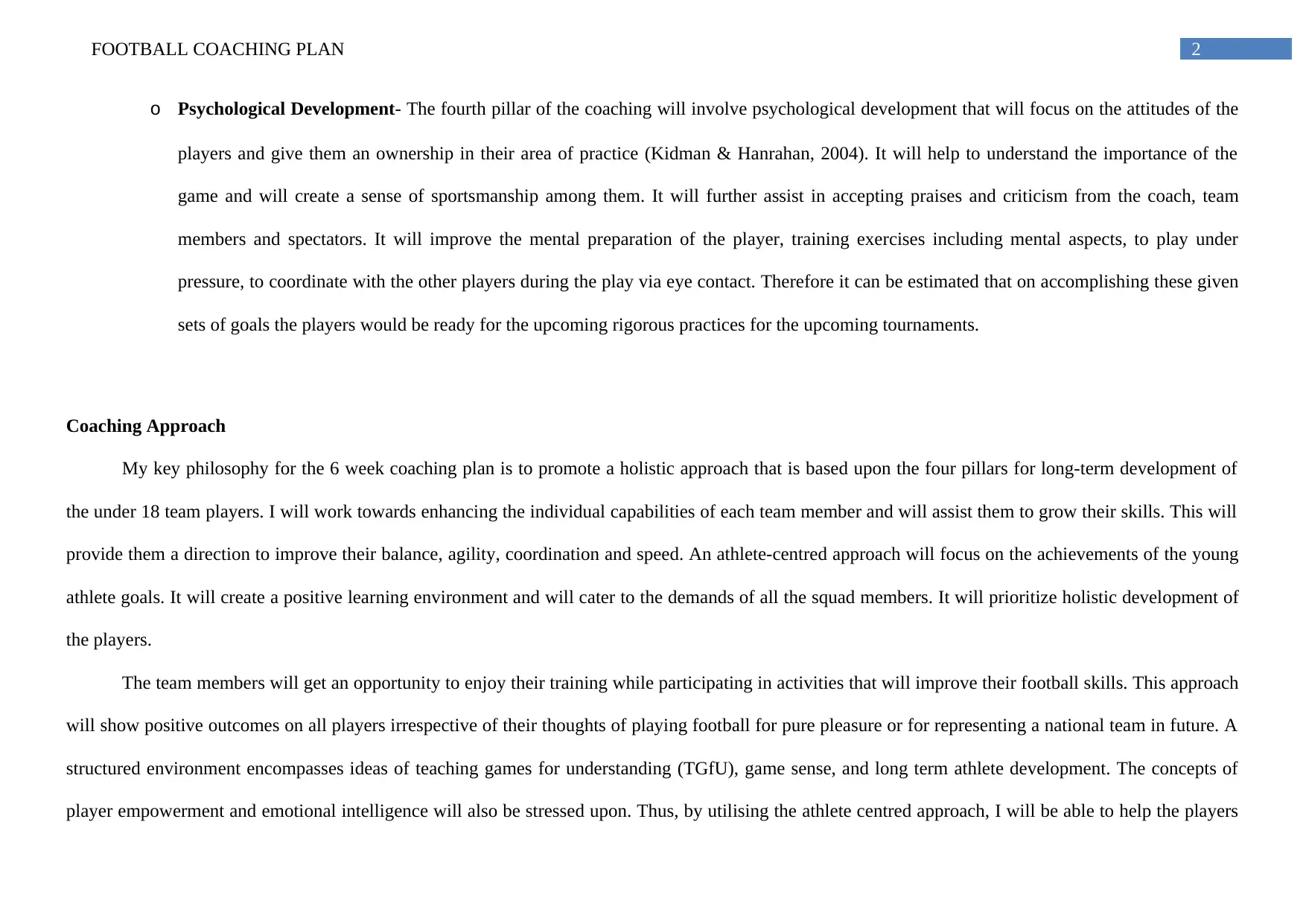
2FOOTBALL COACHING PLAN
o Psychological Development- The fourth pillar of the coaching will involve psychological development that will focus on the attitudes of the
players and give them an ownership in their area of practice (Kidman & Hanrahan, 2004). It will help to understand the importance of the
game and will create a sense of sportsmanship among them. It will further assist in accepting praises and criticism from the coach, team
members and spectators. It will improve the mental preparation of the player, training exercises including mental aspects, to play under
pressure, to coordinate with the other players during the play via eye contact. Therefore it can be estimated that on accomplishing these given
sets of goals the players would be ready for the upcoming rigorous practices for the upcoming tournaments.
Coaching Approach
My key philosophy for the 6 week coaching plan is to promote a holistic approach that is based upon the four pillars for long-term development of
the under 18 team players. I will work towards enhancing the individual capabilities of each team member and will assist them to grow their skills. This will
provide them a direction to improve their balance, agility, coordination and speed. An athlete-centred approach will focus on the achievements of the young
athlete goals. It will create a positive learning environment and will cater to the demands of all the squad members. It will prioritize holistic development of
the players.
The team members will get an opportunity to enjoy their training while participating in activities that will improve their football skills. This approach
will show positive outcomes on all players irrespective of their thoughts of playing football for pure pleasure or for representing a national team in future. A
structured environment encompasses ideas of teaching games for understanding (TGfU), game sense, and long term athlete development. The concepts of
player empowerment and emotional intelligence will also be stressed upon. Thus, by utilising the athlete centred approach, I will be able to help the players
o Psychological Development- The fourth pillar of the coaching will involve psychological development that will focus on the attitudes of the
players and give them an ownership in their area of practice (Kidman & Hanrahan, 2004). It will help to understand the importance of the
game and will create a sense of sportsmanship among them. It will further assist in accepting praises and criticism from the coach, team
members and spectators. It will improve the mental preparation of the player, training exercises including mental aspects, to play under
pressure, to coordinate with the other players during the play via eye contact. Therefore it can be estimated that on accomplishing these given
sets of goals the players would be ready for the upcoming rigorous practices for the upcoming tournaments.
Coaching Approach
My key philosophy for the 6 week coaching plan is to promote a holistic approach that is based upon the four pillars for long-term development of
the under 18 team players. I will work towards enhancing the individual capabilities of each team member and will assist them to grow their skills. This will
provide them a direction to improve their balance, agility, coordination and speed. An athlete-centred approach will focus on the achievements of the young
athlete goals. It will create a positive learning environment and will cater to the demands of all the squad members. It will prioritize holistic development of
the players.
The team members will get an opportunity to enjoy their training while participating in activities that will improve their football skills. This approach
will show positive outcomes on all players irrespective of their thoughts of playing football for pure pleasure or for representing a national team in future. A
structured environment encompasses ideas of teaching games for understanding (TGfU), game sense, and long term athlete development. The concepts of
player empowerment and emotional intelligence will also be stressed upon. Thus, by utilising the athlete centred approach, I will be able to help the players
⊘ This is a preview!⊘
Do you want full access?
Subscribe today to unlock all pages.

Trusted by 1+ million students worldwide
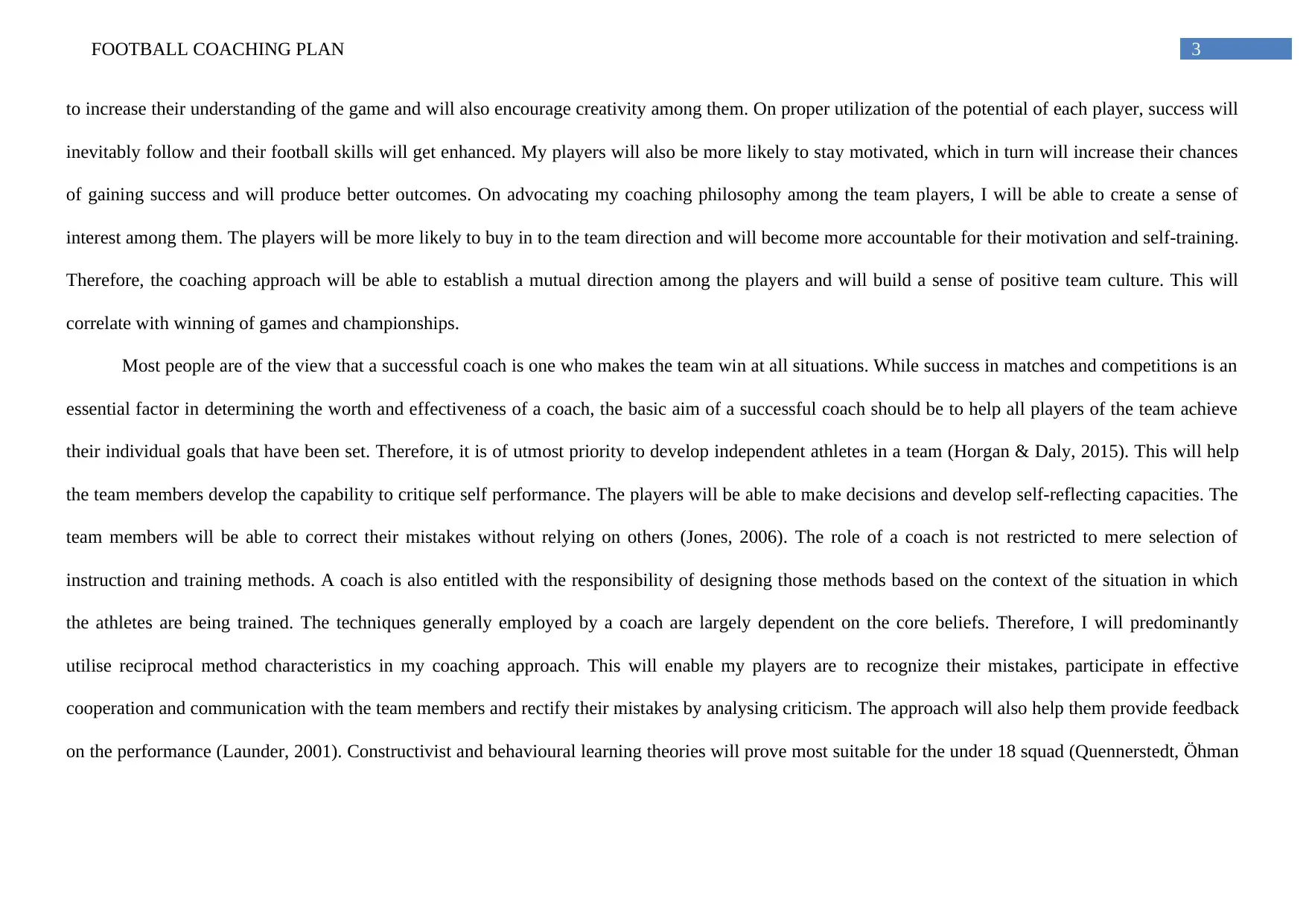
3FOOTBALL COACHING PLAN
to increase their understanding of the game and will also encourage creativity among them. On proper utilization of the potential of each player, success will
inevitably follow and their football skills will get enhanced. My players will also be more likely to stay motivated, which in turn will increase their chances
of gaining success and will produce better outcomes. On advocating my coaching philosophy among the team players, I will be able to create a sense of
interest among them. The players will be more likely to buy in to the team direction and will become more accountable for their motivation and self-training.
Therefore, the coaching approach will be able to establish a mutual direction among the players and will build a sense of positive team culture. This will
correlate with winning of games and championships.
Most people are of the view that a successful coach is one who makes the team win at all situations. While success in matches and competitions is an
essential factor in determining the worth and effectiveness of a coach, the basic aim of a successful coach should be to help all players of the team achieve
their individual goals that have been set. Therefore, it is of utmost priority to develop independent athletes in a team (Horgan & Daly, 2015). This will help
the team members develop the capability to critique self performance. The players will be able to make decisions and develop self-reflecting capacities. The
team members will be able to correct their mistakes without relying on others (Jones, 2006). The role of a coach is not restricted to mere selection of
instruction and training methods. A coach is also entitled with the responsibility of designing those methods based on the context of the situation in which
the athletes are being trained. The techniques generally employed by a coach are largely dependent on the core beliefs. Therefore, I will predominantly
utilise reciprocal method characteristics in my coaching approach. This will enable my players are to recognize their mistakes, participate in effective
cooperation and communication with the team members and rectify their mistakes by analysing criticism. The approach will also help them provide feedback
on the performance (Launder, 2001). Constructivist and behavioural learning theories will prove most suitable for the under 18 squad (Quennerstedt, Öhman
to increase their understanding of the game and will also encourage creativity among them. On proper utilization of the potential of each player, success will
inevitably follow and their football skills will get enhanced. My players will also be more likely to stay motivated, which in turn will increase their chances
of gaining success and will produce better outcomes. On advocating my coaching philosophy among the team players, I will be able to create a sense of
interest among them. The players will be more likely to buy in to the team direction and will become more accountable for their motivation and self-training.
Therefore, the coaching approach will be able to establish a mutual direction among the players and will build a sense of positive team culture. This will
correlate with winning of games and championships.
Most people are of the view that a successful coach is one who makes the team win at all situations. While success in matches and competitions is an
essential factor in determining the worth and effectiveness of a coach, the basic aim of a successful coach should be to help all players of the team achieve
their individual goals that have been set. Therefore, it is of utmost priority to develop independent athletes in a team (Horgan & Daly, 2015). This will help
the team members develop the capability to critique self performance. The players will be able to make decisions and develop self-reflecting capacities. The
team members will be able to correct their mistakes without relying on others (Jones, 2006). The role of a coach is not restricted to mere selection of
instruction and training methods. A coach is also entitled with the responsibility of designing those methods based on the context of the situation in which
the athletes are being trained. The techniques generally employed by a coach are largely dependent on the core beliefs. Therefore, I will predominantly
utilise reciprocal method characteristics in my coaching approach. This will enable my players are to recognize their mistakes, participate in effective
cooperation and communication with the team members and rectify their mistakes by analysing criticism. The approach will also help them provide feedback
on the performance (Launder, 2001). Constructivist and behavioural learning theories will prove most suitable for the under 18 squad (Quennerstedt, Öhman
Paraphrase This Document
Need a fresh take? Get an instant paraphrase of this document with our AI Paraphraser
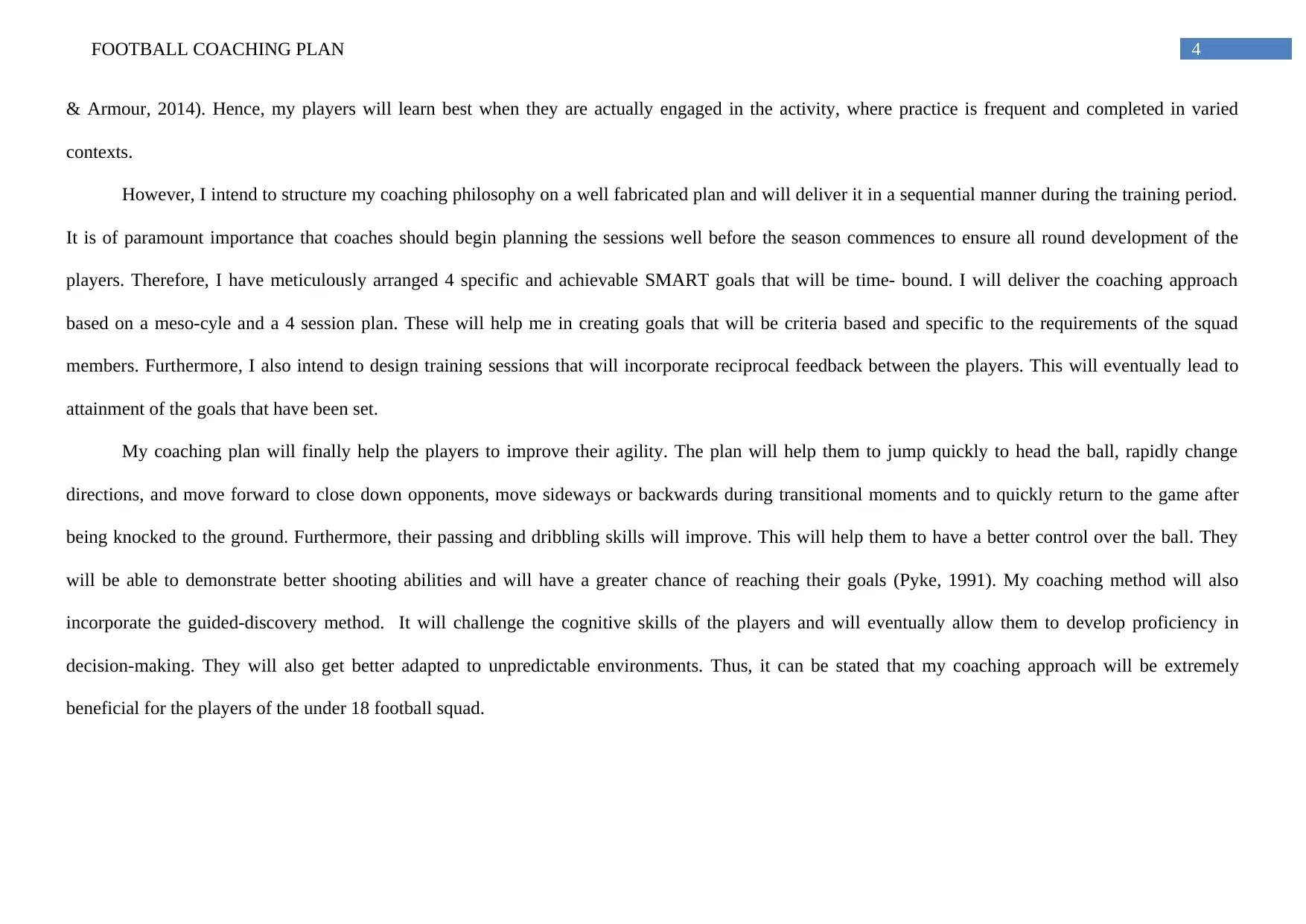
4FOOTBALL COACHING PLAN
& Armour, 2014). Hence, my players will learn best when they are actually engaged in the activity, where practice is frequent and completed in varied
contexts.
However, I intend to structure my coaching philosophy on a well fabricated plan and will deliver it in a sequential manner during the training period.
It is of paramount importance that coaches should begin planning the sessions well before the season commences to ensure all round development of the
players. Therefore, I have meticulously arranged 4 specific and achievable SMART goals that will be time- bound. I will deliver the coaching approach
based on a meso-cyle and a 4 session plan. These will help me in creating goals that will be criteria based and specific to the requirements of the squad
members. Furthermore, I also intend to design training sessions that will incorporate reciprocal feedback between the players. This will eventually lead to
attainment of the goals that have been set.
My coaching plan will finally help the players to improve their agility. The plan will help them to jump quickly to head the ball, rapidly change
directions, and move forward to close down opponents, move sideways or backwards during transitional moments and to quickly return to the game after
being knocked to the ground. Furthermore, their passing and dribbling skills will improve. This will help them to have a better control over the ball. They
will be able to demonstrate better shooting abilities and will have a greater chance of reaching their goals (Pyke, 1991). My coaching method will also
incorporate the guided-discovery method. It will challenge the cognitive skills of the players and will eventually allow them to develop proficiency in
decision-making. They will also get better adapted to unpredictable environments. Thus, it can be stated that my coaching approach will be extremely
beneficial for the players of the under 18 football squad.
& Armour, 2014). Hence, my players will learn best when they are actually engaged in the activity, where practice is frequent and completed in varied
contexts.
However, I intend to structure my coaching philosophy on a well fabricated plan and will deliver it in a sequential manner during the training period.
It is of paramount importance that coaches should begin planning the sessions well before the season commences to ensure all round development of the
players. Therefore, I have meticulously arranged 4 specific and achievable SMART goals that will be time- bound. I will deliver the coaching approach
based on a meso-cyle and a 4 session plan. These will help me in creating goals that will be criteria based and specific to the requirements of the squad
members. Furthermore, I also intend to design training sessions that will incorporate reciprocal feedback between the players. This will eventually lead to
attainment of the goals that have been set.
My coaching plan will finally help the players to improve their agility. The plan will help them to jump quickly to head the ball, rapidly change
directions, and move forward to close down opponents, move sideways or backwards during transitional moments and to quickly return to the game after
being knocked to the ground. Furthermore, their passing and dribbling skills will improve. This will help them to have a better control over the ball. They
will be able to demonstrate better shooting abilities and will have a greater chance of reaching their goals (Pyke, 1991). My coaching method will also
incorporate the guided-discovery method. It will challenge the cognitive skills of the players and will eventually allow them to develop proficiency in
decision-making. They will also get better adapted to unpredictable environments. Thus, it can be stated that my coaching approach will be extremely
beneficial for the players of the under 18 football squad.

5FOOTBALL COACHING PLAN
Meso cycle
Meso cycle
⊘ This is a preview!⊘
Do you want full access?
Subscribe today to unlock all pages.

Trusted by 1+ million students worldwide
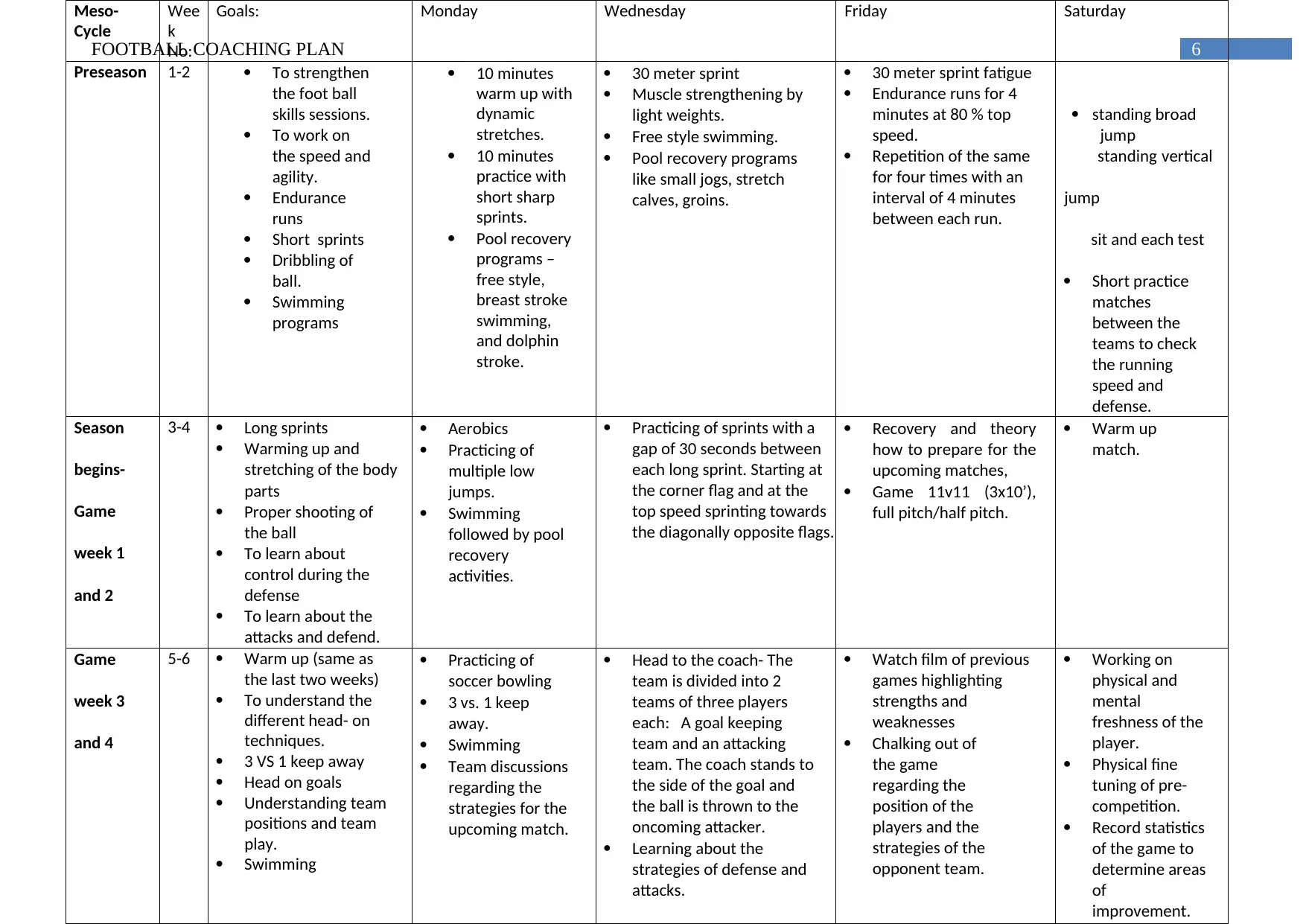
6FOOTBALL COACHING PLAN
Meso-
Cycle
Wee
k
No:
Goals: Monday Wednesday Friday Saturday
Preseason 1-2 To strengthen
the foot ball
skills sessions.
To work on
the speed and
agility.
Endurance
runs
Short sprints
Dribbling of
ball.
Swimming
programs
10 minutes
warm up with
dynamic
stretches.
10 minutes
practice with
short sharp
sprints.
Pool recovery
programs –
free style,
breast stroke
swimming,
and dolphin
stroke.
30 meter sprint
Muscle strengthening by
light weights.
Free style swimming.
Pool recovery programs
like small jogs, stretch
calves, groins.
30 meter sprint fatigue
Endurance runs for 4
minutes at 80 % top
speed.
Repetition of the same
for four times with an
interval of 4 minutes
between each run.
standing broad
jump
standing vertical
jump
sit and each test
Short practice
matches
between the
teams to check
the running
speed and
defense.
Season
begins-
Game
week 1
and 2
3-4 Long sprints
Warming up and
stretching of the body
parts
Proper shooting of
the ball
To learn about
control during the
defense
To learn about the
attacks and defend.
Aerobics
Practicing of
multiple low
jumps.
Swimming
followed by pool
recovery
activities.
Practicing of sprints with a
gap of 30 seconds between
each long sprint. Starting at
the corner flag and at the
top speed sprinting towards
the diagonally opposite flags.
Recovery and theory
how to prepare for the
upcoming matches,
Game 11v11 (3x10’),
full pitch/half pitch.
Warm up
match.
Game
week 3
and 4
5-6 Warm up (same as
the last two weeks)
To understand the
different head- on
techniques.
3 VS 1 keep away
Head on goals
Understanding team
positions and team
play.
Swimming
Practicing of
soccer bowling
3 vs. 1 keep
away.
Swimming
Team discussions
regarding the
strategies for the
upcoming match.
Head to the coach- The
team is divided into 2
teams of three players
each: A goal keeping
team and an attacking
team. The coach stands to
the side of the goal and
the ball is thrown to the
oncoming attacker.
Learning about the
strategies of defense and
attacks.
Watch film of previous
games highlighting
strengths and
weaknesses
Chalking out of
the game
regarding the
position of the
players and the
strategies of the
opponent team.
Working on
physical and
mental
freshness of the
player.
Physical fine
tuning of pre-
competition.
Record statistics
of the game to
determine areas
of
improvement.
Meso-
Cycle
Wee
k
No:
Goals: Monday Wednesday Friday Saturday
Preseason 1-2 To strengthen
the foot ball
skills sessions.
To work on
the speed and
agility.
Endurance
runs
Short sprints
Dribbling of
ball.
Swimming
programs
10 minutes
warm up with
dynamic
stretches.
10 minutes
practice with
short sharp
sprints.
Pool recovery
programs –
free style,
breast stroke
swimming,
and dolphin
stroke.
30 meter sprint
Muscle strengthening by
light weights.
Free style swimming.
Pool recovery programs
like small jogs, stretch
calves, groins.
30 meter sprint fatigue
Endurance runs for 4
minutes at 80 % top
speed.
Repetition of the same
for four times with an
interval of 4 minutes
between each run.
standing broad
jump
standing vertical
jump
sit and each test
Short practice
matches
between the
teams to check
the running
speed and
defense.
Season
begins-
Game
week 1
and 2
3-4 Long sprints
Warming up and
stretching of the body
parts
Proper shooting of
the ball
To learn about
control during the
defense
To learn about the
attacks and defend.
Aerobics
Practicing of
multiple low
jumps.
Swimming
followed by pool
recovery
activities.
Practicing of sprints with a
gap of 30 seconds between
each long sprint. Starting at
the corner flag and at the
top speed sprinting towards
the diagonally opposite flags.
Recovery and theory
how to prepare for the
upcoming matches,
Game 11v11 (3x10’),
full pitch/half pitch.
Warm up
match.
Game
week 3
and 4
5-6 Warm up (same as
the last two weeks)
To understand the
different head- on
techniques.
3 VS 1 keep away
Head on goals
Understanding team
positions and team
play.
Swimming
Practicing of
soccer bowling
3 vs. 1 keep
away.
Swimming
Team discussions
regarding the
strategies for the
upcoming match.
Head to the coach- The
team is divided into 2
teams of three players
each: A goal keeping
team and an attacking
team. The coach stands to
the side of the goal and
the ball is thrown to the
oncoming attacker.
Learning about the
strategies of defense and
attacks.
Watch film of previous
games highlighting
strengths and
weaknesses
Chalking out of
the game
regarding the
position of the
players and the
strategies of the
opponent team.
Working on
physical and
mental
freshness of the
player.
Physical fine
tuning of pre-
competition.
Record statistics
of the game to
determine areas
of
improvement.
Paraphrase This Document
Need a fresh take? Get an instant paraphrase of this document with our AI Paraphraser
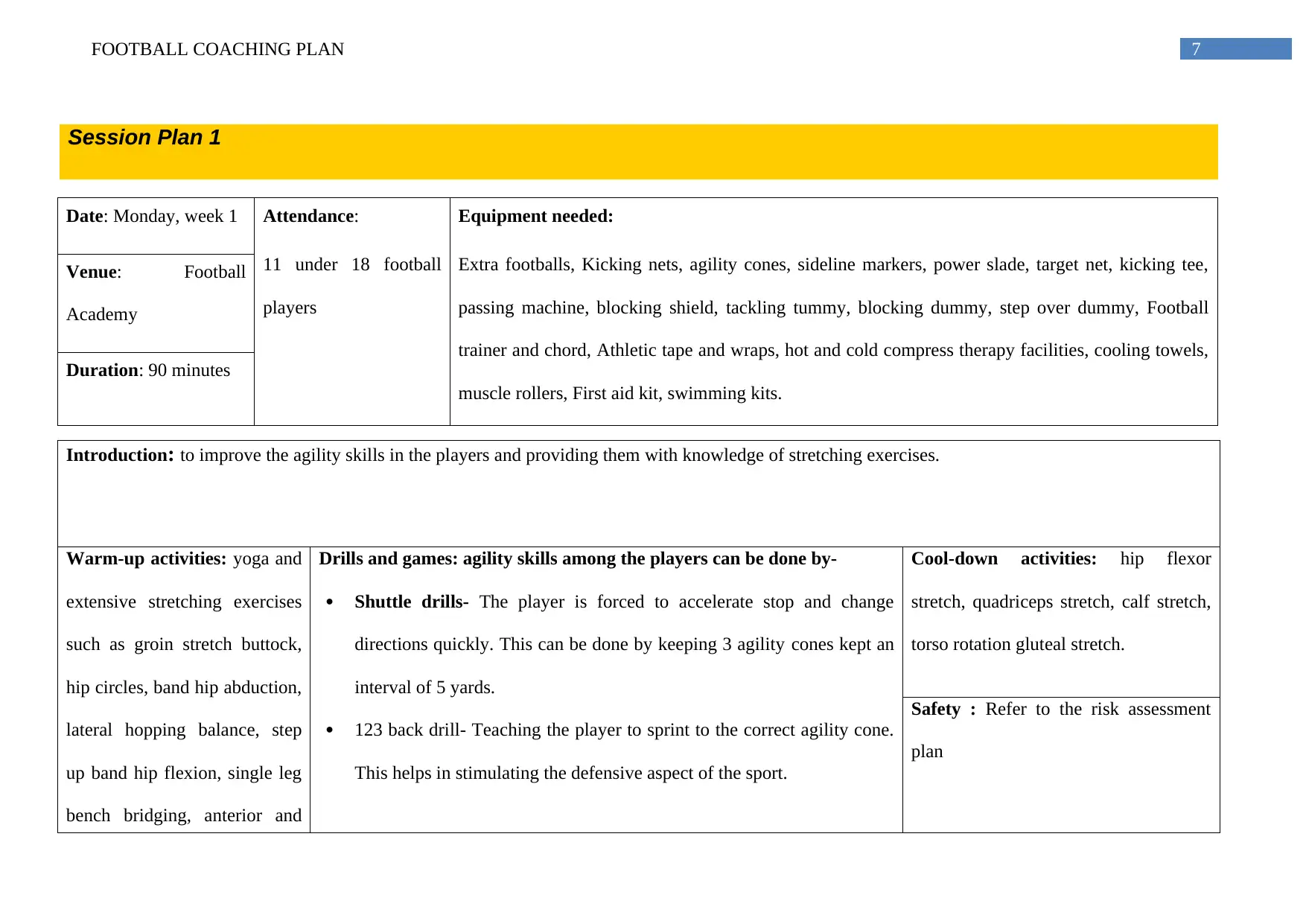
7FOOTBALL COACHING PLAN
Date: Monday, week 1 Attendance:
11 under 18 football
players
Equipment needed:
Extra footballs, Kicking nets, agility cones, sideline markers, power slade, target net, kicking tee,
passing machine, blocking shield, tackling tummy, blocking dummy, step over dummy, Football
trainer and chord, Athletic tape and wraps, hot and cold compress therapy facilities, cooling towels,
muscle rollers, First aid kit, swimming kits.
Venue: Football
Academy
Duration: 90 minutes
Introduction: to improve the agility skills in the players and providing them with knowledge of stretching exercises.
Warm-up activities: yoga and
extensive stretching exercises
such as groin stretch buttock,
hip circles, band hip abduction,
lateral hopping balance, step
up band hip flexion, single leg
bench bridging, anterior and
Drills and games: agility skills among the players can be done by-
Shuttle drills- The player is forced to accelerate stop and change
directions quickly. This can be done by keeping 3 agility cones kept an
interval of 5 yards.
123 back drill- Teaching the player to sprint to the correct agility cone.
This helps in stimulating the defensive aspect of the sport.
Cool-down activities: hip flexor
stretch, quadriceps stretch, calf stretch,
torso rotation gluteal stretch.
Safety : Refer to the risk assessment
plan
Session Plan 1
Date: Monday, week 1 Attendance:
11 under 18 football
players
Equipment needed:
Extra footballs, Kicking nets, agility cones, sideline markers, power slade, target net, kicking tee,
passing machine, blocking shield, tackling tummy, blocking dummy, step over dummy, Football
trainer and chord, Athletic tape and wraps, hot and cold compress therapy facilities, cooling towels,
muscle rollers, First aid kit, swimming kits.
Venue: Football
Academy
Duration: 90 minutes
Introduction: to improve the agility skills in the players and providing them with knowledge of stretching exercises.
Warm-up activities: yoga and
extensive stretching exercises
such as groin stretch buttock,
hip circles, band hip abduction,
lateral hopping balance, step
up band hip flexion, single leg
bench bridging, anterior and
Drills and games: agility skills among the players can be done by-
Shuttle drills- The player is forced to accelerate stop and change
directions quickly. This can be done by keeping 3 agility cones kept an
interval of 5 yards.
123 back drill- Teaching the player to sprint to the correct agility cone.
This helps in stimulating the defensive aspect of the sport.
Cool-down activities: hip flexor
stretch, quadriceps stretch, calf stretch,
torso rotation gluteal stretch.
Safety : Refer to the risk assessment
plan
Session Plan 1
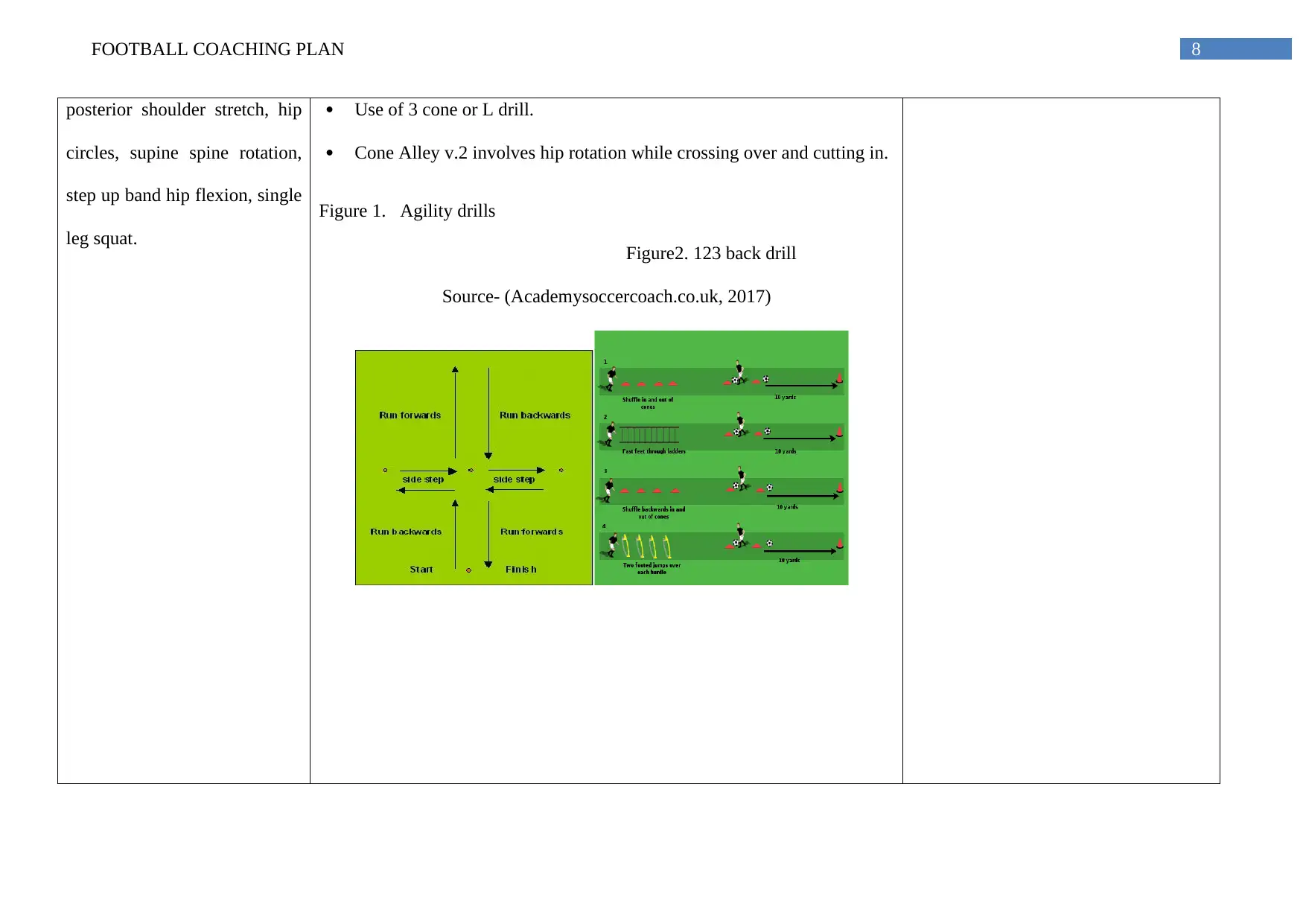
8FOOTBALL COACHING PLAN
posterior shoulder stretch, hip
circles, supine spine rotation,
step up band hip flexion, single
leg squat.
Use of 3 cone or L drill.
Cone Alley v.2 involves hip rotation while crossing over and cutting in.
Figure 1. Agility drills
Figure2. 123 back drill
Source- (Academysoccercoach.co.uk, 2017)
posterior shoulder stretch, hip
circles, supine spine rotation,
step up band hip flexion, single
leg squat.
Use of 3 cone or L drill.
Cone Alley v.2 involves hip rotation while crossing over and cutting in.
Figure 1. Agility drills
Figure2. 123 back drill
Source- (Academysoccercoach.co.uk, 2017)
⊘ This is a preview!⊘
Do you want full access?
Subscribe today to unlock all pages.

Trusted by 1+ million students worldwide
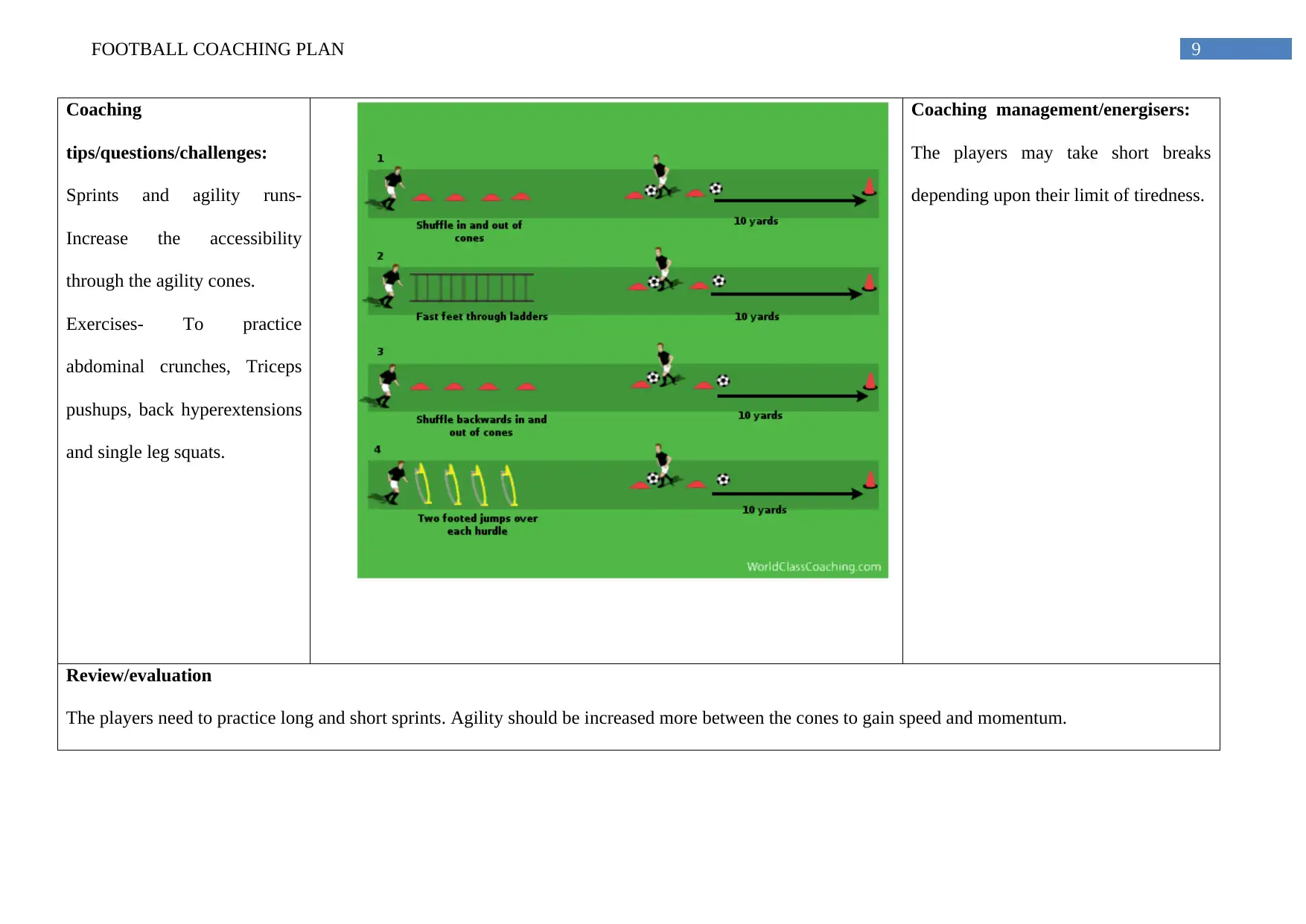
9FOOTBALL COACHING PLAN
Coaching
tips/questions/challenges:
Sprints and agility runs-
Increase the accessibility
through the agility cones.
Exercises- To practice
abdominal crunches, Triceps
pushups, back hyperextensions
and single leg squats.
Coaching management/energisers:
The players may take short breaks
depending upon their limit of tiredness.
Review/evaluation
The players need to practice long and short sprints. Agility should be increased more between the cones to gain speed and momentum.
Coaching
tips/questions/challenges:
Sprints and agility runs-
Increase the accessibility
through the agility cones.
Exercises- To practice
abdominal crunches, Triceps
pushups, back hyperextensions
and single leg squats.
Coaching management/energisers:
The players may take short breaks
depending upon their limit of tiredness.
Review/evaluation
The players need to practice long and short sprints. Agility should be increased more between the cones to gain speed and momentum.
Paraphrase This Document
Need a fresh take? Get an instant paraphrase of this document with our AI Paraphraser
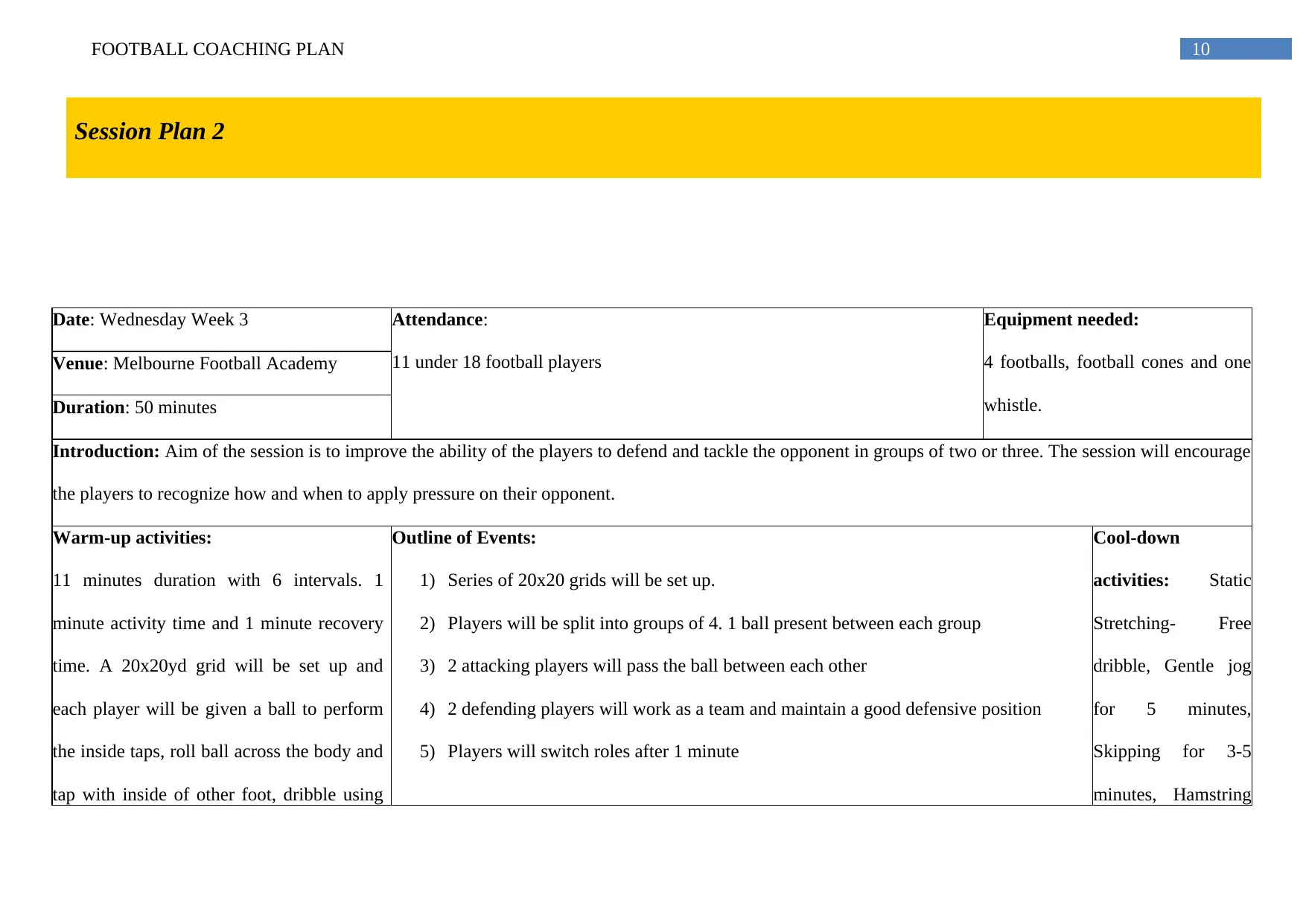
10FOOTBALL COACHING PLAN
Session Plan 2
Date: Wednesday Week 3 Attendance:
11 under 18 football players
Equipment needed:
4 footballs, football cones and one
whistle.
Venue: Melbourne Football Academy
Duration: 50 minutes
Introduction: Aim of the session is to improve the ability of the players to defend and tackle the opponent in groups of two or three. The session will encourage
the players to recognize how and when to apply pressure on their opponent.
Warm-up activities:
11 minutes duration with 6 intervals. 1
minute activity time and 1 minute recovery
time. A 20x20yd grid will be set up and
each player will be given a ball to perform
the inside taps, roll ball across the body and
tap with inside of other foot, dribble using
Outline of Events:
1) Series of 20x20 grids will be set up.
2) Players will be split into groups of 4. 1 ball present between each group
3) 2 attacking players will pass the ball between each other
4) 2 defending players will work as a team and maintain a good defensive position
5) Players will switch roles after 1 minute
Cool-down
activities: Static
Stretching- Free
dribble, Gentle jog
for 5 minutes,
Skipping for 3-5
minutes, Hamstring
Session Plan 2
Date: Wednesday Week 3 Attendance:
11 under 18 football players
Equipment needed:
4 footballs, football cones and one
whistle.
Venue: Melbourne Football Academy
Duration: 50 minutes
Introduction: Aim of the session is to improve the ability of the players to defend and tackle the opponent in groups of two or three. The session will encourage
the players to recognize how and when to apply pressure on their opponent.
Warm-up activities:
11 minutes duration with 6 intervals. 1
minute activity time and 1 minute recovery
time. A 20x20yd grid will be set up and
each player will be given a ball to perform
the inside taps, roll ball across the body and
tap with inside of other foot, dribble using
Outline of Events:
1) Series of 20x20 grids will be set up.
2) Players will be split into groups of 4. 1 ball present between each group
3) 2 attacking players will pass the ball between each other
4) 2 defending players will work as a team and maintain a good defensive position
5) Players will switch roles after 1 minute
Cool-down
activities: Static
Stretching- Free
dribble, Gentle jog
for 5 minutes,
Skipping for 3-5
minutes, Hamstring
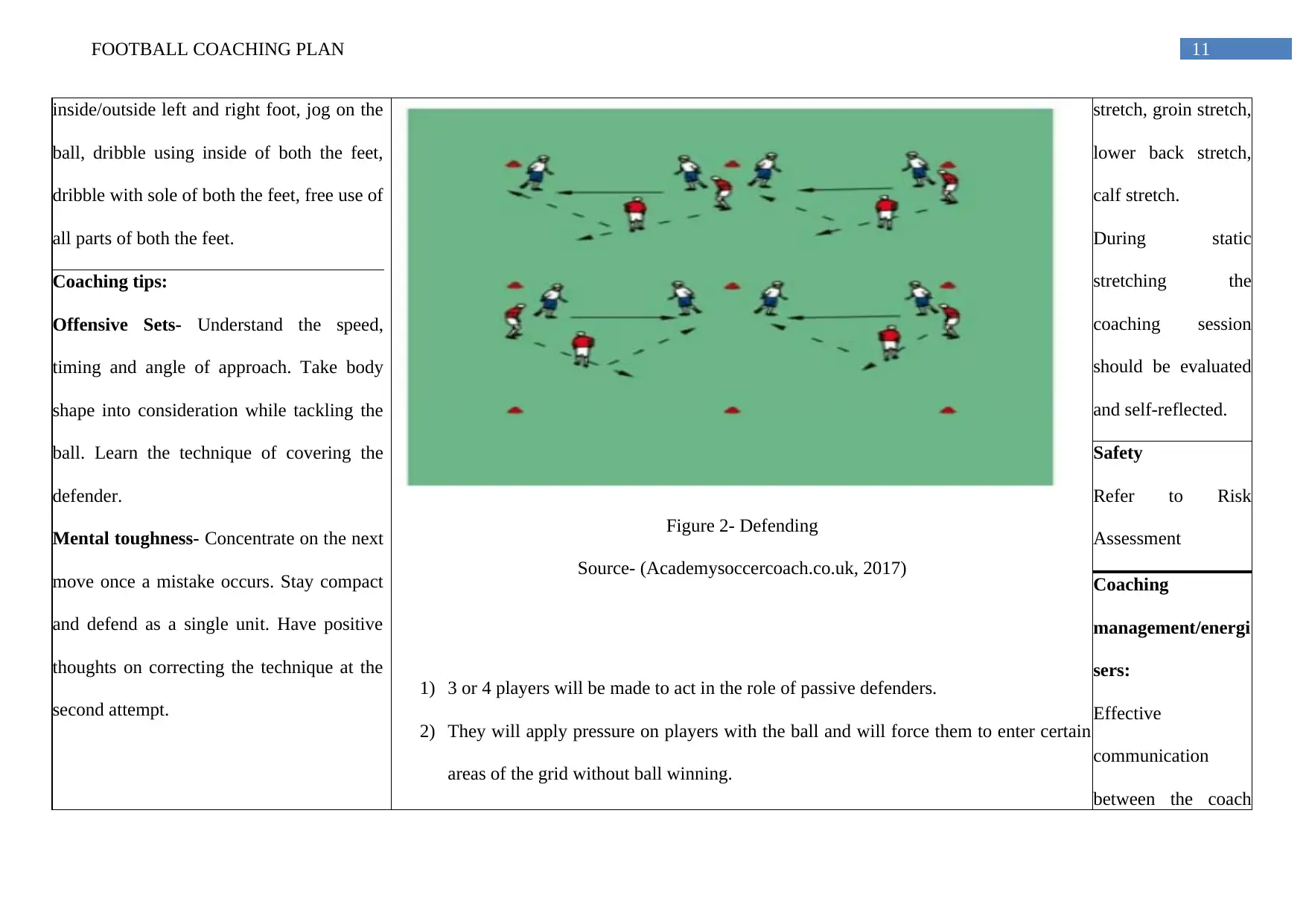
11FOOTBALL COACHING PLAN
inside/outside left and right foot, jog on the
ball, dribble using inside of both the feet,
dribble with sole of both the feet, free use of
all parts of both the feet.
Figure 2- Defending
Source- (Academysoccercoach.co.uk, 2017)
1) 3 or 4 players will be made to act in the role of passive defenders.
2) They will apply pressure on players with the ball and will force them to enter certain
areas of the grid without ball winning.
stretch, groin stretch,
lower back stretch,
calf stretch.
During static
stretching the
coaching session
should be evaluated
and self-reflected.
Coaching tips:
Offensive Sets- Understand the speed,
timing and angle of approach. Take body
shape into consideration while tackling the
ball. Learn the technique of covering the
defender.
Mental toughness- Concentrate on the next
move once a mistake occurs. Stay compact
and defend as a single unit. Have positive
thoughts on correcting the technique at the
second attempt.
Safety
Refer to Risk
Assessment
Coaching
management/energi
sers:
Effective
communication
between the coach
inside/outside left and right foot, jog on the
ball, dribble using inside of both the feet,
dribble with sole of both the feet, free use of
all parts of both the feet.
Figure 2- Defending
Source- (Academysoccercoach.co.uk, 2017)
1) 3 or 4 players will be made to act in the role of passive defenders.
2) They will apply pressure on players with the ball and will force them to enter certain
areas of the grid without ball winning.
stretch, groin stretch,
lower back stretch,
calf stretch.
During static
stretching the
coaching session
should be evaluated
and self-reflected.
Coaching tips:
Offensive Sets- Understand the speed,
timing and angle of approach. Take body
shape into consideration while tackling the
ball. Learn the technique of covering the
defender.
Mental toughness- Concentrate on the next
move once a mistake occurs. Stay compact
and defend as a single unit. Have positive
thoughts on correcting the technique at the
second attempt.
Safety
Refer to Risk
Assessment
Coaching
management/energi
sers:
Effective
communication
between the coach
⊘ This is a preview!⊘
Do you want full access?
Subscribe today to unlock all pages.

Trusted by 1+ million students worldwide
1 out of 24
Related Documents
Your All-in-One AI-Powered Toolkit for Academic Success.
+13062052269
info@desklib.com
Available 24*7 on WhatsApp / Email
![[object Object]](/_next/static/media/star-bottom.7253800d.svg)
Unlock your academic potential
Copyright © 2020–2025 A2Z Services. All Rights Reserved. Developed and managed by ZUCOL.




